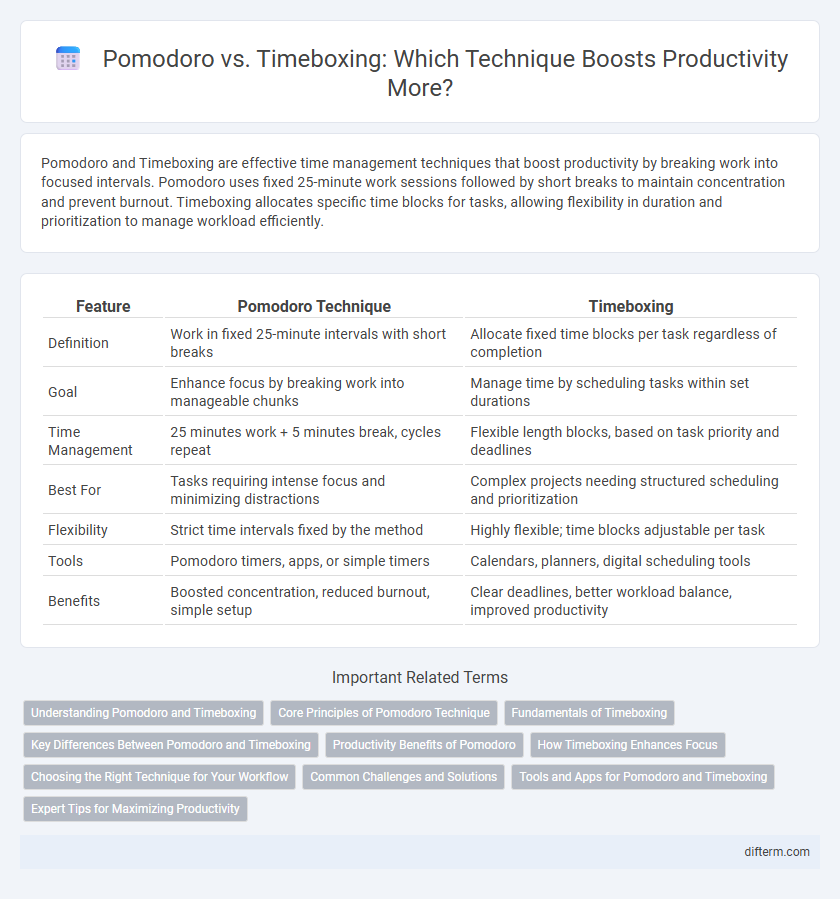Pomodoro and Timeboxing are effective time management techniques that boost productivity by breaking work into focused intervals. Pomodoro uses fixed 25-minute work sessions followed by short breaks to maintain concentration and prevent burnout. Timeboxing allocates specific time blocks for tasks, allowing flexibility in duration and prioritization to manage workload efficiently.
Table of Comparison
| Feature | Pomodoro Technique | Timeboxing |
|---|---|---|
| Definition | Work in fixed 25-minute intervals with short breaks | Allocate fixed time blocks per task regardless of completion |
| Goal | Enhance focus by breaking work into manageable chunks | Manage time by scheduling tasks within set durations |
| Time Management | 25 minutes work + 5 minutes break, cycles repeat | Flexible length blocks, based on task priority and deadlines |
| Best For | Tasks requiring intense focus and minimizing distractions | Complex projects needing structured scheduling and prioritization |
| Flexibility | Strict time intervals fixed by the method | Highly flexible; time blocks adjustable per task |
| Tools | Pomodoro timers, apps, or simple timers | Calendars, planners, digital scheduling tools |
| Benefits | Boosted concentration, reduced burnout, simple setup | Clear deadlines, better workload balance, improved productivity |
Understanding Pomodoro and Timeboxing
Pomodoro is a time management technique that breaks work into 25-minute focused intervals followed by short breaks, enhancing concentration and preventing burnout. Timeboxing allocates fixed time periods to specific tasks, allowing for better scheduling and deadline-driven productivity. Both methods improve task completion by promoting disciplined work sessions and reducing procrastination.
Core Principles of Pomodoro Technique
The Pomodoro Technique centers on breaking work into 25-minute focused intervals called "Pomodoros," separated by short breaks to enhance concentration and prevent burnout. This method leverages the principle of time-limited effort to maintain sustained productivity and manage mental fatigue effectively. By tracking completed Pomodoros, individuals can measure progress and optimize task planning within their workflow.
Fundamentals of Timeboxing
Timeboxing anchors tasks within fixed time periods to enhance focus and prevent scope creep by setting clear start and end times. Unlike the Pomodoro Technique, which uses uniform intervals typically around 25 minutes, timeboxing flexibly allocates varying durations tailored to task complexity and priorities. By establishing strict boundaries, timeboxing cultivates disciplined work habits and optimizes productivity through structured time management.
Key Differences Between Pomodoro and Timeboxing
Pomodoro technique divides work into fixed 25-minute intervals called Pomodoros, separated by short breaks, optimizing focus and preventing burnout. Timeboxing allocates specific time periods for entire tasks or activities, allowing flexibility in how the work is managed within those limits. Pomodoro emphasizes structured work-rest cycles to maintain mental stamina, while timeboxing prioritizes managing deadlines and overall task completion within a preset timeframe.
Productivity Benefits of Pomodoro
Pomodoro technique enhances productivity by breaking work into focused 25-minute intervals, reducing mental fatigue and improving concentration. Its structured breaks help maintain high energy levels, preventing burnout and sustaining motivation throughout the day. This method promotes effective time management and task prioritization, leading to increased overall output and efficiency.
How Timeboxing Enhances Focus
Timeboxing enhances focus by allocating fixed, predetermined periods to specific tasks, reducing decision fatigue and minimizing distractions. Unlike the Pomodoro Technique's rigid intervals, timeboxing offers flexibility, allowing customization based on task complexity and individual work rhythms. This precise scheduling fosters sustained concentration and efficient task progress, driving higher productivity.
Choosing the Right Technique for Your Workflow
Pomodoro and Timeboxing both enhance productivity by structuring work intervals, but choosing the right technique depends on your task complexity and focus requirements. Pomodoro suits tasks needing sustained concentration with its 25-minute work and 5-minute break cycles, while Timeboxing offers flexibility by allocating fixed time slots for specific activities, ideal for diverse workloads. Evaluating your workflow's demands and personal attention span can guide selecting the most effective method to maximize efficiency and task completion.
Common Challenges and Solutions
Pomodoro and Timeboxing both face challenges such as distractions, inaccurate task estimation, and maintaining consistent focus during intervals. Solutions include using dedicated apps to track sessions, setting clear task boundaries, and incorporating short breaks to prevent burnout. Employing customizable timers and reviewing progress regularly enhances adherence to productivity techniques and improves time management efficiency.
Tools and Apps for Pomodoro and Timeboxing
Popular productivity tools for Pomodoro include Focus Booster, Pomodone, and TomatoTimer, which offer customizable intervals and built-in timers to enhance time management. Timeboxing apps like Toggl Plan, Clockify, and TimeBloc provide calendar integration and task scheduling features that help allocate fixed time slots for specific activities. Both Pomodoro and Timeboxing tools support improved focus and task prioritization by structuring work sessions and breaks effectively.
Expert Tips for Maximizing Productivity
Pomodoro and Timeboxing are productivity techniques that experts recommend for enhancing focus and time management by breaking work into manageable intervals. Pomodoro uses 25-minute focused work sessions followed by short breaks, ideal for maintaining high concentration and reducing burnout. Timeboxing allocates fixed time periods to specific tasks, promoting discipline and preventing task overrun, with experts advising to combine both methods for optimal productivity.
Pomodoro vs Timeboxing Infographic

 difterm.com
difterm.com